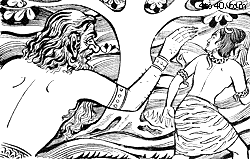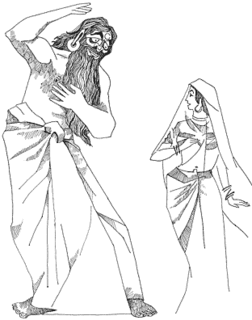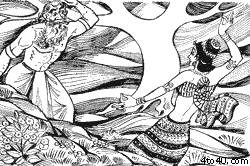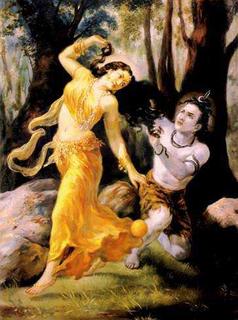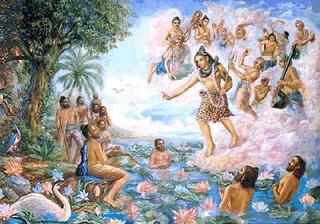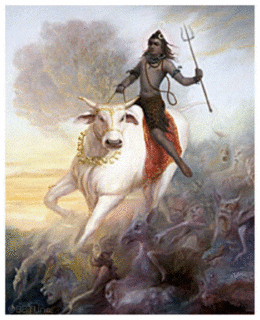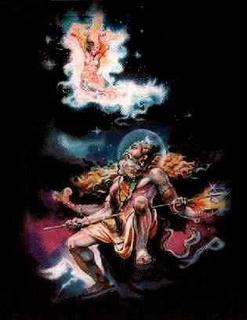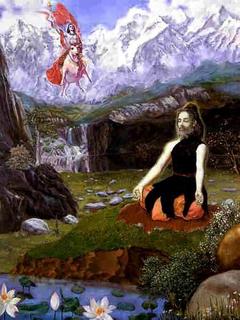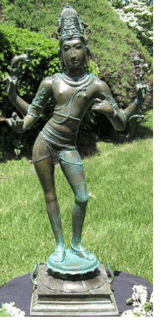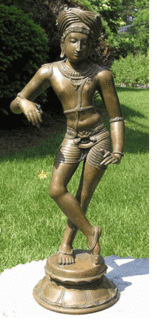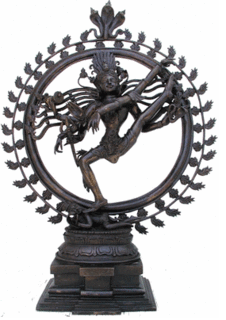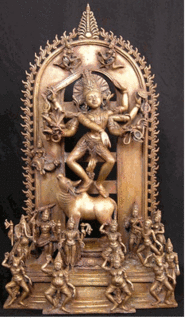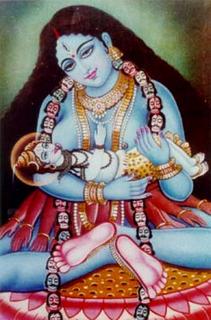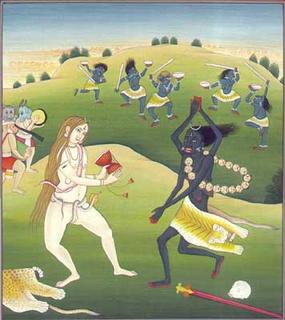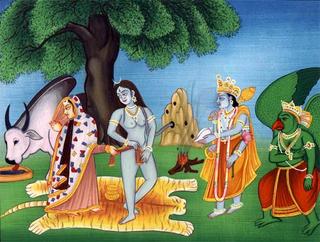 The most benevolent king Bali, who had donated the whole earth to Lord Vishnu, disguised as a dwarf, had hundred sons. Banasura was his eldest son. He was intelligent, generous, and truthful and was respected for his qualities. He was also a great devotee of Lord Shiva.
The most benevolent king Bali, who had donated the whole earth to Lord Vishnu, disguised as a dwarf, had hundred sons. Banasura was his eldest son. He was intelligent, generous, and truthful and was respected for his qualities. He was also a great devotee of Lord Shiva.
Banasura had his capital at 'Shonitpur' near Kedarnath in the Himalayan region. He had thousand hands. He did penance for thousands of years. While Lord Shiva performed his famous 'Tandav Nritya', he used to play the 'mridanga' with his thousand hands. Pleased by his devotion, Lord Shiva asked him to demand any boon.
Banasura smiled and said, "I am grateful to you for your kind offer. By your grace I have everything I want. I am now a great king. I am so strong that all the others kings and even the gods dare not stand against me.""Then you have nothing to wish for," said Shiva."I have something to wish for," replied Banasura. "Although I have fought and won many battles, still I fear I may have some enemies. Since you have kindly promised to grant me whatever I wish for, my wish is that you will come with your family and guard the gates of my city."Shiva was shocked. He was very angry. But he was helpless. He had promised to grant Bana's wish and now he could not withdraw from his promise.
So Lord Shiva, his consort Parvati, and their children all came down to earth and stood guard at the gates of Banasura's city. Banasura was happy that now the great Shiva himself was serving under him. He informed all the other kings of his remarkable achievement and he invited many to come and see Lord Shiva working as his servant.
He was constantly in search of a warrior with whom he could fight. The great warriors used to run away on seeing Banasura. The deities became frightened and 'Indra' accepted his defeat. There was no one in all the 3 worlds that could defeat him. All these things made Banasura very proud.
One day Banasura went to Lord Shiva and said, "I am tried of my lazy life. I want to have the excitement of war. My hands are itching for a fight. Shall I get the chance to fight somebody who is a match for me?""Yes, yes," replied Shiva. "You will certainly get the chance.""When? When?" asked Bana eagerly. "I want to know when I shall get the chance to fight. I am impatient.""Keep a watch on your flag on the flag-staff," said Shiva. "When you see the flag-staff broken and the flag fallen down then you will know that the chance for a fight is coming. You will have to fight a great person. He will defeat Bana? Let this great person come and I shall show him what I am worth."From that day onwards Banasura kept a close watch on his flag flying on the flag-staff.Banasura had a beautiful daughter named Usha. Usha was in the prime of youth and received many proposals of marriage. But her father did not agree to any of them.
Usha had a companion named Chitralekha. Chitralekha was the daughter of one of Bana's ministers, and she was the cleverest and most talented woman the world had ever seen. She was very well educated and she was a great artist. She knew everybody who was of any importance in heaven or on earth.One night Usha dream that she was in the company of a very handsome prince. He showed great interest in her and she fell in love with him. Suddenly she woke up and found that the prince was gone."Where are you? Come to me," she called loudly but there was no reply.Then she searched for him in her room and outside. When she could not find him anywhere, she burst into tears.Chitralekha heard her crying. She went in and asked what had happened. Usha told her that a young and handsome prince had come to her but he had suddenly vanished."You must bring him back to me," she said. "If you can't, I have no desire to live."Chitralekha knew that Usha had only been dreaming. It would be very difficult to find the young man Usha had seen in her dream. However, she promised to try to find him.Chitralekha thought deeply over the matter. Who could have appeared before Usha? It might be one of the gods, for some of then had played such tricks before. Or perhaps it was one of the kings. She wrote down the names of all the gods and kings and princes whom Usha might have seen in her dream. She then began to draw the picture of each one in turn.She began with the gods. She drew Indra and showed the picture to Usha."No," said Usha, "that is not the man I saw."Then Chitralekha drew the pictures of kings and princes, but Usha said that none of them resembled her dream lover.Chitralekha then drew Sri Krishna. Usha said that there was some likeness, but he was not the man.Then she drew the picture of Krishna's son. Usha said there was more likeness, but her lover was much younger.Chitralekha smiled and drew the picture of Anirudha, Krishna's grandson, who was famous for his beauty, and showed it to Usha.Usha snatched the picture away and said to it, "You, my beloved, why did you go away?""He is the man," she said to Chitralekha. And she kept the picture close to her heart.Chitralekha knew that it was Anirudha with whom Usha had fallen in love. She told Usha who the young man was and explained that it would be a difficult task to get him."Nothing is difficult for you," said Usha. "You must get him for me or I shall die."
"Keep calm, Usha," Chitralekha replied. "I promise I shall try my best to find him and bring him to you."It was midnight when Chitralekha set out on her mission. Unseen by anyone she went to Lord Krishna's palace. She searched from room to room and at last found Anirudha sleeping in his room.Chitralekha had certain magic powers. She made Anirudha continue to sleep while she lifted him up and put him on her back. She carried him out of the palace and took him away to Bana's city. She went straight to Usha's room.
It was dawn when she reached there. She laid Anirudha on Usha's bed.Usha was very happy to see Anirudha and she kissed Chitralekha in gratitude. Chitralekha left the saying that she would come back when Anirudha woke up.Anirudha slept for a long time. Usha was gazing at his handsome face. She wanted to wake him up and talk to him. But she was afraid to disturb him. Gently fanned him.At last Anirudha opened his eyes and looked around. He was surprised to find himself in a strange place. He looked at Usha in astonishment. She was very beautiful and he liked her very much. But who was this woman?He sat up and said to Usha, "Who are you? Where am I? How did I come here? Have we met before?"Usha said, "I am Usha, the daughter of king Bana. This is my room. Yes, we have met before. We met only in my dream. I fell in love with you and wanted to be with you always. My friend Chitralekha brought you here. Oh, please stay with me!"
Anirudha felt confused. What should he do? Should he stay with Usha or should he return home? Usha was so loving and so lovely that he did not want to leave her. But how could he stay with her? Usha was not married to him. And what would his father and grandfather think when they learnt that he was staying with Bana's daughter?"What are you thinking?" asked Usha, looking at him eagerly. "Neither my people nor yours will approve of our marriage. But we are made for each other. Please stay with me.""You are very beautiful," said Anirudha. "I love you very much and I would like to marry you. But it would not be wise to do so without the consent of our parents. Let us consult them first.""You don't know my father," said Usha. "He will never agree to our marriage.""But we can argue with him and make him change his mind," said Anirudha."I do not know what he will do if he sees you here," said Usha in despair.
Anirudha and Usha were still talking when a maid-servant came in. she saw the handsome stranger in Usha's room. She went and reported the matter to Bana.Bane at once rushed to his daughter's room. He was shocked to find Usha in the company of a handsome young man. Bana shouted and roared with anger and fell upon the young man to kill him. Anirudha defended himself bravely.But Bana was a giant. He overpowered the young prince and was about to kill him when Usha rushed between them and cried, "Father, don't do him any harm. He is my guest. He did not come here by himself. He is innocent. He has not done anything wrong. If any wrong has been done, it is I who has done it. He must not be punished for the wrong I did. You can punish me, you can even kill me if you so desire. But don't touch even a hair of my guest, this noble young prince."Bana was taken aback. Usha had never talked to him so boldly before.
He was furious and wanted to kill them both. But he thought for a while and then bound Anirudha's hands and feet and dragged him out and put him in prison.
In the meantime it had been discovered that Anirudha was missing from the palace of Lord Krishna. It was strange that the young prince had suddenly vanished. Nobody had any idea where he had gone. Had he been kidnapped? Or had he met with some disaster? A search was made, but the prince could not be found.
Then Narada, the wandering sage, went to Krishna and informed him that his grandson was in Bana's prison. Krishna was surprised. How had Anirudha fallen into the hands of Bana? Bana was an Asura and he would not release Anirudha easily. Krishna knew that the only way to get back his grandson was to wage a war on Bana.Then Krishna gathered a large army and marched to Banasura's capital.
In the distance, Krishna saw Bana's flag flying on a tall flag-staff. He shot an arrow. The arrow broke the flag-staff and the flag fell down.Bana saw the flag-staff broken and the flag fallen down. He knew that the time had come for a fight.
He was jubilant. He had been waiting for this for a long time. He assembled his army and marched out to meet the enemy.He was met outside by the huge army of Krishna. The battle began between the two forces. It was fierce battle and most of the men in Bana's army were killed. Bana went ahead to face Krishna.Krishna destroyed Bana's chariot. Bana jumped down and challenged Krishna. Krishna accepted the challenge and began a terrible fight. Krishna was winning. He was just going to kill Bana when suddenly Bana's mother came and stood between her son and Krishna."Do not kill my son," she cried. "Kill me first before you harm my son!"Krishna stopped the fight to talk to her.In the meantime Bana ran and took shelter in the palace.
Shiva was still guarding the gate of the city. Since an enemy had come and attacked Bana, the city was threatened and it was his duty to protect it.Shiva did not have a large army, so he had to find a new way to overcome the enemy and make them unable to fight. He produced the germs of fever and spread them among Krishna's army.Krishna's soldiers all began to develop high fever and started shivering. Soon, one after another, they fell to the ground.Krishna saw what had happened to his soldiers. He had to do something quickly to save their lives.
He produced germs which would destroy Shiva's germs, and spread them among his soldiers, soon all his soldiers were quite well again and they stood up and were ready to fight.Then Banasura collected a large army and came out and started the battle again against Krishna's army.
But Krishna and his men fought fiercely, and soon Bana's army was completely defeated.Again Krishna and Banasura met in single combat. Krishna was about to kill Bana.
But Lord Shiva came forward and asked him to spare Bana's life.
Krishna paid homage to Shiva and then said, "Bana has committed all kinds of crimes. He even cheated you and made you his servant. He does not deserve mercy. But if you want him to live, let him promise to mend his ways."
Bana fell at Krishna's feet and said that he was sorry for all he had done. He promised that in future he would be a different man.
Lord Krishna said : " On one hand he is a Shiva devotee and on the other, he is the great grandson of Prahlad. I have taken a vow, not to kill any descendant of Prahlad, so I won't kill him but simply severe his thousand hands which are like a useless weight to him, leaving only four of them. From today onwards, he would be the chief courtier of Shiva and would become immortal."
Bana then turned to Shiva and apologized for the crime he had committed in cheating him and making him serve as his gatekeeper.
Shiva forgave him and said that he was happy that he had been able to protect Bana from Krishna's wrath.
Bana's life was thus saved. Then he went and brought Usha and Anirudha and handed them over to Krishna.Krishna received them with love. He took them home with him and celebrated their marriage. All lived happily ever after.




